¿Te interesa realizar un curso online de tècnicas del tejido en telar con Anna Champeney?Si te interesa aprender técnicas de diseño y tejido en telar de bajo lizo online, escríbanos y suscribir a nuestro boletín.
 Contacta con nosotros |
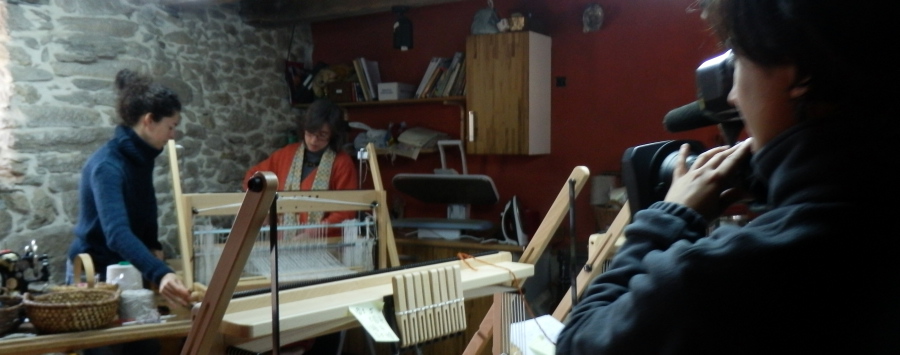 Anna Champeney (r) with weave pupil Ana Roman (l) being filmed by Televisión Gallega for the regional magazine programme "Great Places"
Yesterday and today the habitual tranquility and silence of the picturesque Galician hamlet of Cristosende was broken as the village was taken over by the film crew of TVG for the making of Grandes Lugares (Great Places), a regional magazine programme. Yesterday a good number of us villagers turned up at the old school, to share a glass of local wine, some empanada (traditional pie), and bread with a selection of cheeses and village-made chorizo and salchichón sausage, and explain to the film crew exactly what makes the village so special for us. Is it the fact that the village has a stunning view over some of the most dramatic scenery in the Ribeira Sacra area of north Spain? Or that, in a village of only about 30 inhabitants, there are no fewer than 3 local businesses – the craft workshops with Casa dos Artesans holiday cottage, the Casa Grande rural hotel and bar, and Pepe´s bodega, Viña Perderneira. Or is it simply the fact that the village has a pretty good atmosphere, with neighbours always willing to help each other out? This morning the film crew came to Anna Champeney Estudio Textil and Lluis Grau´s basketry workshop to conduct interviews, both with the local craftspeople themselves and Ana Roman, a weave student who explained how satisfying it was to weave her own soft alpaca scarf on a loom – and how relaxing it is too (except, of course, when 5 members of a film crew are filming you!). Well, we´re not going to tell you anything else for now, but will post up the video link when we know the date of emission, and invite you to watch – and meet all our neighbours here in Cristosende.
Padded doubleweave textiles – Doubleweave tuition option now available – Weaving holidays for intermediate level weavers in Spain
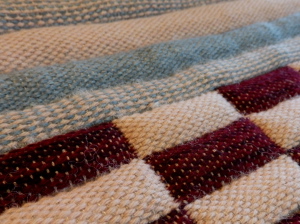 Photo of padded double weave fabric (Anna Champeney Estudio Textil Spain))
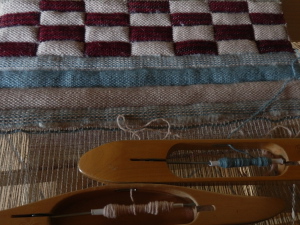 Weaving "quilted" fabrics with 2 shuttles on a Louet table loom
Giving an interview whilst weaving doubleweave with two shuttles is no easy task – it´s like trying to whistle and hum at the same time (and I only know one person who can do that!), so the TV crew had to wait and watch a little until the moment came to stop weaving and insert the stuffing into the “pockets” and “tubes” created by the double weave! Weaving textiles on the loom in two layers opens the door to lots of magical and seemingly impossible options – from weaving a textile which is actually wider than the loom you are using to weaving a tube, to weaving two layers of fabric which intersect to create pockets – which can be filled with filling which gives you an effect rather like a quilted textile. Applications? Double weave is great for scarves and (using very fine yarns) for clothing fabrics which are really warm and insulating but which can still drape nicely, without feeling not lumpy or thick. But the thick quilted-effect double weave fabrics can also be used for thick padded jackets, cushion pads, bedcovers and upholstery fabrics. The only limit is your imagination. Anna Champeney and Lluis Grau offer one-to-one tuition in their craft workshops and looms for hire to guests staying at their holiday cottage, Casa dos Artesans. Their availability as tutors in 2012 is already limited so you are advised to reserve the cottage and any tuition well in advance. Contact.
 It´s July in the Ribeira Sacra and hand-weaver and designer, Anna Champeney, and basketmaker, Lluis Grau, are working hard in order to make their textile and basketry studios ready to open to the public during August, when they have their their summer selling exhibition and open studios. Their places of work are situated in beautifully-restored traditional stone buildings in the picturesque village of Cristosende which overlooks the famous River Sil Canyon itself. Here´s a sneak preview of what is to come when they finally open for the month of August. It´s July in the Ribeira Sacra and hand-weaver and designer, Anna Champeney, and basketmaker, Lluis Grau, are working hard in order to make their textile and basketry studios ready to open to the public during August, when they have their their summer selling exhibition and open studios. Their places of work are situated in beautifully-restored traditional stone buildings in the picturesque village of Cristosende which overlooks the famous River Sil Canyon itself. Here´s a sneak preview of what is to come when they finally open for the month of August.
July – As well as running a weaving course from the studio from the 4th – 8th July Anna, the hand-weaver at AC Textile Studio, is busy weaving up 55m of linen yarn on the loom– making large-size linen farm sacks with colourful stripes and a personalised cushion commission. Do the sacks actually have a modern-day use or are they just decorative reminders of the past? “The sacks are nice to look at and hang up but they are actually very practrical – they are machine-washable for example – and have many modern-day uses as well as constituting part of the region´s local craft heritage. At home I use one of the large sacks as a bread bag but I also love using it for picnics and some clients of mine have even converted them into cushions! I also make smaller versions which can be used as bathroom bags, as handbags, for garden seeds, just about anything really – it´s not so different today as in the past – the sacks have always been multi-purpose”. What is the history behind the traditional rustic linen farm sacks in Galicia? I have researched traditional folk textiles in Galicia since the early 2000s and the rustic linen sacks were certainly a core part of the traditional weaver´s repertoire in my area of mountainous northwest Spain – Ourense province. Similar, rougher sacks, were made in neighbouring Asturias, but I find the Galician sacks finer. Some local people still use the old sacks in my area but unfortunately I was never able to meet any of the old weavers as they died years ago. The fact that the old weavers´ sacks are still in use is a real tribute to the weavers and proof, if any was needed, of their robustness. The traditional sacks were originally larger than the modern versions woven at the Textile Studio, as they were used to take grain to the water mills and for large quantities of sweet chestnuts which formed the staple diet of many local people not that long ago. But people don´t need such large sacks today for home use so, unless I receive a commission for a full-size sack, I weaver them in smaller sizes. The stripey versions of the sacks were locally called “sacos róxos” (red sacks), something of a mystery, given the fact that they could be black, brown, red or blue. But they were always stripey and we weave the sacks using the same kinds of stripes as before”. These traditional Galician sacks some of Anna´s favourite stock items and she finds them very satisfying to weave. The colours are from natural dyes extracted from plants in the workshop itself – some of which are from plants grown in the dye workshop garden – you can´t get much more local than that! The end of June is when camomila tinctoria or dyer´s chamomile can be harvested and Anna has a large flat basket full of drying flower-heads in the studio which she will later use to dye woollen sack yarn. Can visitors see the natural dyeing process in the workshop during a visit? “Well we do offer guided tours for the public both during our opening hours in August and during the rest of the year (when telephone booking is required) which means visitors can learn more about the way that hand-made textiles and baskets are made here and see whatever we are working on at the time. I usually do large-scale batch dyeing about twice a year, a process which can take several weeks so yes, there is a chance of seeing either the yarns being dyed or some of the plants I use and colours that I obtain”. “Craft” is a bit of a confusing word today as it covers a huge range of things from cheap, imported objects which have been mass-produced to exclusive hand-made objects which are unique and command a high value. What kind of craft is on offer at the Cristosende craft workshops? At AC Estudio Textil and Lluis´ basketry workshop we offer craft work which has been authentically hand-made, locally, but us, and made from natural materials. Local, traditional craft is amongst the most authentic as it is often tied to the history of a particular area. Despite being more expensive than some objects sold as craft in shops we feel that our work offers real value-for-money as it is not only genuine but well-crafted – it´s the “real thing” not an imitation or a fake version. Some of the techniques we use are over 1000 years old and the methods we use are all completely manual. Ironically, although some of the objects we make today might have been commonplace about 50 or 100 years ago today they are rare – and in some cases we are the only makers in Spain making particular types of basket or woven textile for sale. Our clients come not only from Galicia but also from Madrid, Barcelona and abroad. Some clients are collectors, many are visitors to the area – but in general they are all searching for something unusual, authentic and different to what is normally on sale. We select traditional designs and techniques which we find beautiful ourselves and which can also find a use in modern life. Our textiles and baskets are often used, not just looked at on a shelf. At the textile studio we also produce our own label textiles – with designs which go beyond traditional designs and techniques and sometimes use more complex techniques and more creative designs. The own-label designs include limited editions of scarves and cushions and one-off pieces as well as textile art pieces. Our prices range from just 9.50€ for a mini-textile to 26.50€ for a strong mushroom basket, to over 500€ for a decorative framed piece; there is something for everyone. What´s new in the Cristosende craft workshops for 2010? We always try to introduce new ranges or designs in our August open workshops. New for 2010 are some lovely linen babycapes – ideal for the heat of summer (linen is cooler and more absorbent than cotton). They are quite different to industrial babycapes and can be used for formal and informal occasions, and as both towels and summer blankets. In the basket range we hope to have some of the very special traditional baskets which are traditional in the Los Ancares area of Galicia, which are not only rare but very beautiful. We will have some old favorites on display too – including mushroom baskets and potato-peeling baskets.
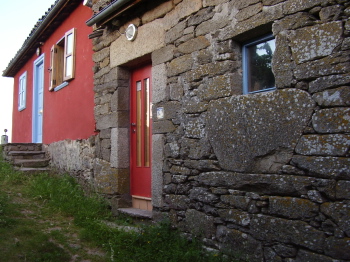 Public Opening Hours Public Opening Hours
- August 2010 – 10.30am – 1.30pm / 6 – 8.30pm (every day except Mondays). Guided Visits on requestduring opening hours – 2,50€ per adult
- Rest of the year – the craft workshops are closed to the public but you can book a guided tour or visit by appointment – T.669 600 620.
Map
You may have heard about the red alert storm warnings in north Spain yesterday, 27 February 2010. Well, Xynthia, as the storm was called in Galicia, raged all around us yesterday afternoon and evening. We battened down the hatches – well, closed the shutters on our stone workshops – and weathered the storm. here in north Spain we have escaped much of the snow affecting more northerly European countries but we have had torential rains which have led to severe flooding in some areas. Here in the Ribeira Sacra, at 600m up, it is the wind which affects us most, and not least during Xynthia, where winds of up to 200 km/h were recorded. In fact, I was so carried away with my weaving during hurricane Xynthia that the constant roar of the wind and the flickering on-and-off of the electric lighting and the radio didn´t really affect me, except when the light began to fade and I had to go and get a candle. Such is the excitement of weaving fine singles silk, linen and 52/2 overspun wool into a gorgeously-textured scarf. 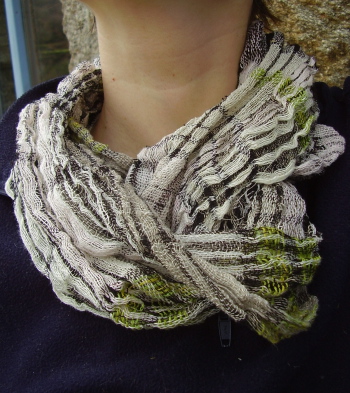
I´m going to take it with me when I demonstrate next week at Xantar (= “Lunch”) the 5 day food festival in Ourense, the city 40 minutes away from Anna Champeney Textile Studio.
Bye for now!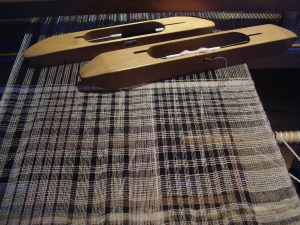
|
Pago seguro
 NUEVO Octubre 2023 Curso presencial setmanal de teixits de baix lliç (Girona)!Un curso nou, setmanal (3h) a Sant Gregori, Girona, amb l'Anna Champeney. Trimensual, plaças limitadas).
Octobre 2023. Ven a aprender a diseñar y realizar tejidos en telar de bajo lizo a mano. Docente: Anna Champeney, profesional desde 2004, con marca textil propia, experta en tejido de bajo lizo, docente en la Escola Massana, Barcelona.
 Haga clic aquí para informarte |





 It´s July in the Ribeira Sacra and hand-weaver and designer, Anna Champeney, and basketmaker, Lluis Grau, are working hard in order to make their textile and basketry studios ready to open to the public during August, when they have their their summer selling exhibition and open studios. Their places of work are situated in beautifully-restored traditional stone buildings in the picturesque village of Cristosende which overlooks the famous River Sil Canyon itself. Here´s a sneak preview of what is to come when they finally open for the month of August.
It´s July in the Ribeira Sacra and hand-weaver and designer, Anna Champeney, and basketmaker, Lluis Grau, are working hard in order to make their textile and basketry studios ready to open to the public during August, when they have their their summer selling exhibition and open studios. Their places of work are situated in beautifully-restored traditional stone buildings in the picturesque village of Cristosende which overlooks the famous River Sil Canyon itself. Here´s a sneak preview of what is to come when they finally open for the month of August. Public Opening Hours
Public Opening Hours



